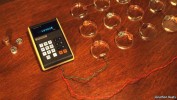 HIGH-SPEED currency trading uses oodles of computing power to exploit short-lived price differences in international foreign-exchange markets. Jonathon Keats proposes an alternative: exploit the electrical differences between currencies to power a low-speed computer. In an exhibit which opens on April 12th at the Rockefeller Centre in New York Mr Keats, a concept artist (or, as he likes to call himself, an experimental philosopher), introduces the notion “electro-chemical arbitrage”. An engineer might call it a battery.
HIGH-SPEED currency trading uses oodles of computing power to exploit short-lived price differences in international foreign-exchange markets. Jonathon Keats proposes an alternative: exploit the electrical differences between currencies to power a low-speed computer. In an exhibit which opens on April 12th at the Rockefeller Centre in New York Mr Keats, a concept artist (or, as he likes to call himself, an experimental philosopher), introduces the notion “electro-chemical arbitrage”. An engineer might call it a battery.
When a battery’s electrode is immersed in its electrolyte, positive metal ions are formed on its surface. These ions pass into the solution, making the electrode progressively more negative as the positive charges move away. A dynamic equilibrium is created between those ions leaving and those attracted back to the negatively charged metal surface. At the other electrode, meanwhile, a similar process is taking place. If both electrodes are made of the same metal, each will charge to the same extent, and so no current will flow. Use different metals, though, and their reactivities will differ; one will become more charged than the other, producing a voltage. Close the circuit using an external wire and the electrons will flow through it to balance the current flowing through the electrolyte. That external current can then do useful work, like powering electric gadgets.
An American cent is 95% zinc with a copper coating. The Chinese fen (nominally worth about one-sixth of a cent), meanwhile, is coated in aluminium. Crucially for Mr Keats’s project, copper and aluminium react at different rates with a salt solution. So by placing the Chinese and American pecuniary electrodes in a petri dish filled with brine, and stringing together a handful of such mini-cells (see picture), he could conjure up a potential difference as high as 18.7 volts. That is enough to power three handheld calculators.
The coins will not last for ever: the chemical reactions leave them corroded and depleted (which is why all chemical batteries run out of juice after a while). Still, they should be more than enough to crunch some simple sums. That initial order, from Jon Tolson, of Tolson Capital Management, a financial services firm in San Francisco, is to add 5 and 17. Mr Keats is running that first calculation free of charge, “in the interest of attracting a larger data-processing contract”. Good luck with that.
First published by The Economist’s Babbage blog: [html] [pdf]